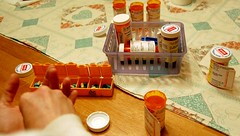 Image via Wikipedia
Image via Wikipedia Last October, a reporter from radio's version of Public Television, National Public Radio (commonly referred to as NPR), conducted a telephone interview with me about CCSVI. I came to her attention because of the many posts on CCSVI that have appeared on this blog, in addition to the fact that I'd undergone CCSVI treatment in March, 2010. A full list of my CCSVI posts appears in the left column of this website, under the heading "CCSVI Related Posts".
Originally, the NPR piece was supposed to air on November 1, but the air date was pushed back pending further research being done by the reporter, Gretchen Cuda Kroen. I was told the completed piece would run sometime early in 2011, but was never given a firm air date.
Low and behold, this morning my phone began to ring quite early, with friends and family reporting that they had heard me on the radio. As I have steadfastly sworn off the morning hours since MS forced my "retirement" from the working world, and I tend to rise at the crack of noon, I was happy to learn that the report was available on NPR's website (click here). I was quite honored to find that the other two interviewees in the piece are both highly distinguished physicians conducting very important research on CCSVI, Dr. Robert Fox of the Cleveland Clinic, and Dr. Robert Zivadinov of the Buffalo Neuroimaging Analysis Center. All I did was have a catheter snaked through my jugulars...
Just a few comments on the report…
While it's fantastic that CCSVI is finally getting some media attention here in the United States, I think the report overstated some of the hazards involved with undergoing CCSVI venoplasty. It talks about "several patients" dying from blood clots resulting from the use of stents in their jugular veins. In truth, we know of one patient who died of an aneurysm most likely brought on by the anticoagulant drugs she was put on post procedure, and another who did die from a clot that developed in an implanted stent. The use of stents in treating CCSVI has come to be a cause of concern to many of the doctors currently doing the CCSVI venoplasty procedure, and many, if not most, are now primarily using balloon venoplasty in treating patients. Thus far, no patient deaths have been attributed to balloon venoplasty, although cases of thrombosis (clotting) and restenosis (surgically opened veins collapsing once again) are acknowledged problems.
The piece quotes me as saying that I wished I had waited for more research to be done before undergoing the procedure. While this is true, it is not due to safety concerns, but rather to the fact that mine is a complicated case, and the techniques being used to treat CCSVI are in a constant state of evolution. Procedures being done now are much different than those done only six months ago, and those done six months from now will without doubt be all the more sophisticated. This is why I've recommended in previous posts that patients with milder and less aggressive disease might want to consider holding off on getting the procedure done, because their chances of longer lasting success will certainly increase with time. I do agree with the piece's warnings about medical tourism, because many patients have indeed spent large sums of money, and traveled many thousands of miles, only to find that if they did get benefit from the procedure, it was unfortunately temporary. It's also important to remember that a substantial number of patients do not get any benefit at all from the procedure, and expectations must be kept realistic.
One factual error included in the piece is that Dr. Zivadinov believes that the venoplasty procedure is unsafe, which is clearly not the case. His research group at BNAC is currently conducting a treatment trial which recently increased the number of patients included, a strong indication that he does not consider CCSVI treatment as prohibitively dangerous. I contacted a representative from BNAC, and they assured me that Dr. Zivadinov in no way intended to infer that CCSVI venoplasty is a hazardous undertaking.
It would've also been nice to have heard from a patient who, unlike me, had experienced real benefit from CCSVI treatment, as many have. Since the piece is only 5 1/2 min. long, I'm sure the reporter was limited in what she could pack into it, and we all know that a full discussion of CCSVI and its related issues could only properly be covered in a much longer exploration. Hopefully, this report will be the tip of the iceberg, and will spur the rest of the US media to finally start doing its job, and get quality information out to the public at large. The mainstream media's complete silence on this issue has been egregious, but I wouldn't hold my breath in anticipation of an onslaught of reporting.
In other CCSVI related news, the National Multiple Sclerosis Society released its first six month report on the CCSVI trials it funded this past summer (click here). Though the report does not contain any trial results, it does provide much information on the nuts and bolts of the projects funded. Although it's unfortunate (in my opinion) that none of the NMSS funded projects is a treatment trial, it is encouraging to read that many of the researchers involved have undergone training in the specific methods used by Dr. Zamboni to detect CCSVI, and have acquired the specialized equipment required to do so. I look forward to the Society's next research update six months from now, which hopefully will include some of the initial data being gleaned by these studies.







